Caishiyinshi (literally “Market Silver Collecting Envoy”) was an envoy office established during the Tang Dynasty. Envoy offices were occupied by officials dispatched outside the system of regularly appointed officials. Most of them were in charge of specific matters and held a certain measure of real power. This was an important episode in the evolution of official positions during the Tang Dynasty.
In the first year of Tianbao period, Weizhou was renamed Anbian Prefecture, which was located in Wei County, Hebei Province, today. At first, it had two counties under jurisdiction, namely, Lingqiu and Feihu. Another county, called Anbian, was established within Feihu in the 12th year of Kaiyuan period and was later renamed Xingtang County. Weizhou was under jurisdiction of Hedong Dao Administrative Division and under the control of jiedushi (regional military governor) of Hedong.
Hengye Corps was part of the frontier forces of the Tang Dynasty and under the command of jiedushi of Hedong. Its main mission was to coordinate with the forces of Shuofang Dao Administrative Division in defense against Turkic invasion. The headquarters of Hengye Corps was originally in Lingqiu County. In the 12th year of Kaiyuan period, the government established Anbian County near the stationed troops of Hengye Corps in Lingqiu. In the first year of Tianbao period, the seat of the prefectural government was also relocated from Lingqiu to Anbian. In the second year of Zhide period, Hengye Corps joined the rebels in the fight against the government in Taiyuan. A year after that, the name of Hengye Corps was abolished.
During the Tang Dynasty, it was sometimes challenging to maintain a timely supply of food and provisions to troops stationed along the borders due to the difficulty of access. As a result, the government encouraged the soldiers to reclaim wasteland and farm the fields themselves so as to become self-sufficient. In most units there was a Garrison Fields Manager (yingtianshi) in charge of such farmland and public land. Guo Zi'ang probably also held the office of commander of Hengye Corps in addition to those of the prefect of Anbian and the Garrison Fields Manager of Hengye Corps, though it is omitted in the inscription on the silver ingot.
Ningyuan General was a non-regular military rank. The highest rank attained by Guo Zi'ang was the fourth, not the third; thus he was entitled to the bestowment of a 'purple goldfish pouch', which agrees with the inscription on the silver ingot.
No biography of Guo Zi'ang can be found in either Book of Tang or New Book of Tang, but the name appears in the epitaph composed by Yan Zhenqing for his cousin Yan Gaoqing, according to which Guo was a steadfast follower of An Lushan. The possibility cannot be ruled out that the two Guos were the same person, though this cannot be ascertained. The resistance to the rebels by counties in Hebei is also described by Yao Runeng in the Biography of An Lushan, where it is mentioned that a Guo Zimao was killed in Guangping. Probably Guo Zimao was a corruption of the name Guo Zi'ang.
Four more Tang silver ingots have been discovered in China so far.
1. This silver ingot is 9.6 cun long and 2.15 cun wide, and weighs 67.2 liang. The front bears a line of engraved words in the middle--'Presented by Yang Guozhong, Supervisor of Mintage in All Dao Administrative Divisions and the Deputy Minister of Defense,Deputy Chief Imperial Censor. On the back are three lines of words: 'Yuchi Yan, Prefect of Xin'an' (the first line); 'Commissioner Zhi Tingshang' (the second line); and 'One silver ingot, 50 taels, the XX day of the first lunar month in the 10th year of Tianbao period'. This silver ingot is now collected in Shaanxi History Museum. (Fig. 1)
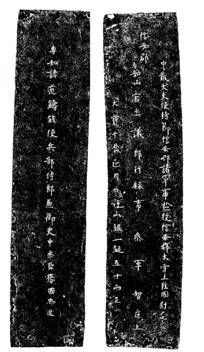
Fig. 1 Silver ingot 1 (from Huo Hongwei and Dong Qing: 'Study of the Peng Gao Silver Ingot of the
Tang Dynasty Collected in the National Museum of China', in China Numismatology, 2011 (2))
2. This silver ingot is 1.1 chi long and 2.25 cun wide, and weighs 67.7 liang. The front bears a line of words: 'Presented by Yang Guozhong, Supervisor of Mintage in All Dao Administrative Divisions,Assistant Minister of War,Deputy Chief Imperial Censor'. The back has three lines of words: 'One silver ingot made in Xuancheng, 50 taels' (the first line); 'Miao Fengqian, Prefect of Xuancheng' (the second line); and 'The 29th day of the 4th lunar month in the 10th year of Tianbao period' (the third line). This silver ingot is now collected in the National Museum of Chinese History. (Fig. 2)
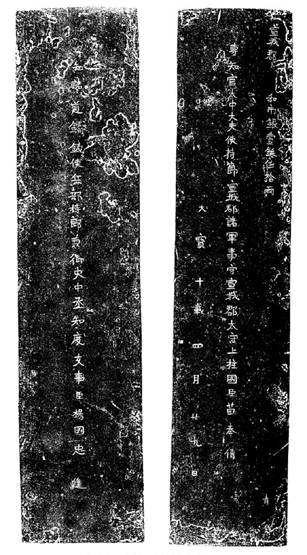
Fig. 2 Silver ingot 2 (from Huo Hongwei and Dong Qing: 'Study of the Peng Gao Silver Ingot of the
Tang Dynasty Collected in the National Museum of China', in China Numismatology, 2011 (2))
3. This silver ingot is 7.6 cun long and 2.1 cun wide, and weighs 62.4 liang. The front bears a line of words in the middle: 'Presented by Peng Gao, prefect of Nanhai'. In the upper right corner are the words '50 taels of silver'. There is no inscription on the back. This silver ingot is now in Shaanxi History Museum. (Fig. 3)
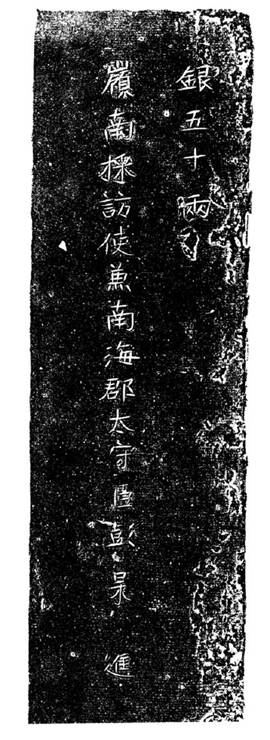
Fig. 3 Silver ingot 3 (from Huo Hongwei and Dong Qing: 'Study of the Peng Gao Silver Ingot of the
Tang Dynasty Collected in the National Museum of China', in China Numismatology, 2011 (2))
4. This silver ingot is 7.4 cun long and 1.75 cun wide, and weighs 65 liang. The words on the front, though blurred, can be made out to be 'One ingot presented as tribute by the Langning Prefectural Governor's Office in the second year of Tianbao period, fifty taels, ' (the first line), 'He Rupu, supervisor of various military affairs' (the second line), and ‘Chen Ruyu, Chen Guangyuan…' (the third line). [22] There is no inscription on the back. This silver ingot is now collected in the History Museum of China. (Fig. 4)

Fig. 4 Silver ingot 4 (from Huo Hongwei and Dong Qing: 'Study of the Peng Gao Silver Ingot of the
Tang Dynasty Collected in the National Museum of China', in China Numismatology, 2011 (2))
All these silver ingots were made in the periods of Kaiyuan and Tianbao, and were probably closely related to Emperor Xuanzong and Yang Guozhong as well as the social ethos, various institutions, and the outbreak of the An Lushan Rebellion. During the flourishing period of Kaiyuan, the country enjoyed social stability and rapid economic growth. Intoxicated by the prosperity, Emperor Xuanzong led an increasingly extravagant life and became more and more covetous of gold, silver and other expensive metals. By reforming the taxation system, Yang Guozhong ordered that all the heavy tributes submitted to the court by local authorities be converted into light goods. Catering to his preference, local officials presented large amounts of gold and silver. Just as the national treasury was filled to the brim, the An Lushan Rebellion broke out. Emperor Xuanzong beat a hasty retreat to Sichuan, and the enormous amounts of treasures he carried were dispersed among common people, plundered by the rebels, or buried underground.
These silver ingots presented by local authorities attest to the historical records about Yang Guozhong's attempts to accumulate wealth for Emperor Xuanzong by continual tax reforms. The most interesting of these silver ingots is the one collected in Henan Museum, for it reflects not only Yang Guozhong's wealth-extorting service for the emperor, but also An Lushan's disguise of loyalty and feigned cooperation with Yang before his rebellion.
Why was the silver ingot presented by Yang Guozhong, now in the collection of Henan Museum, found in Luoyang, while all the other silver ingots were unearthed or otherwise discovered in Xi'an?
Your answer please, if you have any questions or answer, please feel free to send us email, we are waiting for your answers and participation, and your comments, answers and suggestions will be highly appreciated. We will select and publicize the most appropriate answers and comments some time in the future.
Weekly Selection Email: meizhouyipin@chnmus.net
In the spring of 1970, a silver ingot and a silver cake were found during the construction of an underground pipeline for a pharmaceutical factory in Luoyang City, Henan Province. The silver ingot, which was cast in the shape of a long strip, with a curved top and two quasi-right-angle lower corners. The front bears the engraved words 'presented by Yang Guozhong, Market Silver Collecting Envoy, Prime Minister and Minister of Personnel'; the back has the engraved words 'one silver ingot for government transactions in Anbian Prefecture, fifty taels' in the upper part, and the following engraved words in the lower part (from right to left)--'Guo Zi'ang, Prefect, Ningyuan General, Deputy Commander of the Left Defense Headquarters, Garrison Fields Manager of Hengye Corps, and recipient of a purple goldfish pouch bestowed by the emperor, the XX day of the twelfth lunar month in the twelfth year of Tianbao period' [1].
Since the inscriptions involve in economic, political and military aspects of the Tang Dynasty, the silver ingot is of high academic value as precious physical material for our understanding and studying of the Tang society and its political, economic and military institutions.
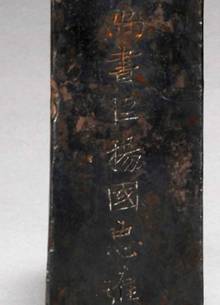
The front of the silver ingot presented by Yang Guozhong (detail)

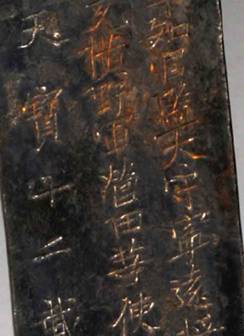
The back of the silver ingot and the inscription on it
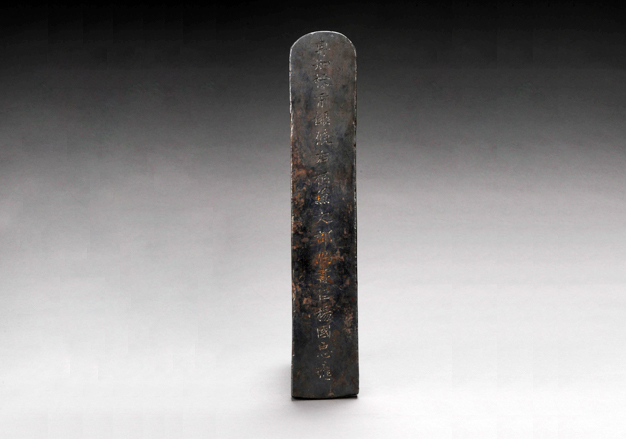

Editor of journal Heritages in Central Plain, with a master degree on ancient history, serving in Research Dept.of Henan Museum at present